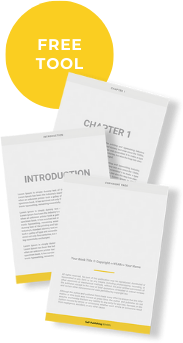In the literary sphere, a motif is a deliberate, artistic decision that can elevate your narrative to a higher level. Whether you write novels, scripts, poetry, or anything else, understanding how to use motifs can enrich your work.
Let’s look at some examples, definitions, and tips for writing with motifs.
- What is a motif?
- 11 literary examples of motifs
- How to use motifs in your own writing
- Common mistakes with motifs


Book Outline Generator
Choose your Fiction or Nonfiction book type below to get your free chapter by chapter outline!
Book Outline Generator
Enter your details below and get your pre-formatted outline in your inbox and start writing today!
CONGRATULATIONS
Thanks for submitting! Check your email for your book outline template.
In the meantime, check out our Book Outline Challenge.

What is a motif?
A motif is an element, theme, pattern, symbol, or other element that recurs in literature. It can also apply in the art and music sphere, as well as generally any artistic medium, but we’re going to focus on literary usage.
11 literary examples of motifs
You can pick out multiple motifs in any work of writing—they’re nearly impossible to avoid. Here are a few deliberate examples.
1. Fire in Hunger Games by Suzanne Collins
In the Hunger Games series, we get many motifs, one of the most consistent being fire and flame imagery.
Fire is a constant symbol throughout the series, representing destruction and rebirth. The main character, Katniss, is named The Girl On Fire because of her styling before the Games. Her stylist puts her in dresses to represent coal, embers, and fire, because she comes from District 12, which produces coal for the nation. Further in the series, fire becomes a symbol of revolution.
“If we burn, you burn with us!”
Mockingjay
2. Duality in The Circle Trilogy by Ted Dekker
The premise of this series is that a character falls asleep in the normal world and wakes in a fantasy world. Every time he sleeps, he travels back and forth. This begins the motif of duality.
As the story progresses, we learn that each character struggles with some conflict related to their dual natures. In the fantasy world, every person has an “other” self, which might be the good version of them, the evil version of them, or some other form of duality. Good and evil, light and dark, forest and desert, night and day. The symbolism of duality appears everywhere.
Many situations in the stories present two choices to the main characters and force them to choose between the two options.
“How can there be love without a true choice?”
The Circle Trilogy
3. Pessimistic Immortality Twilight by Stephenie Meyer
This is a theme explored in many vampire stories—is it a good thing to be immortal? The motif arises throughout the series up until Bella Swan is turned into a vampire herself. Our main instigator of the question is Rosalie Cullen. She was killed soon before she was meant to be married, looking forward to a life with her husband and future children. When that life was stolen from her (by the man himself), Rosalie fixated on the concept.
She even goes as far as wearing her wedding dress as she murders the men who killed her one by one—honestly, slay. As a vampire, she cannot conceive, thus making her feel that a life of immortality is hollow and joyless. She warns Bella many times not to squander her mortality.
“I’d never given much thought to how I would die…”
Twilight
4. Letters in This Is How You Lose The Time War by Amal El-Mohtar and Max Gladstone
The format of this book heavily relies on letters and written correspondence—they take up more than half of the page space. Red and Blue, agents on the opposite sides of the time war, swap letters with one another in cheeky and clever ways, hiding them in places like inside of tree trunks or inside of a beaver’s organs. They (SPOILERS) fall in love through letters, then the letters end up saving them. Letters and writing in general are pivotal elements and repeated motifs throughout the story.
“One spared life might be worth more to the other side than all the blood that stained Red’s hands today. A fugitive becomes a queen or a scientist, or, worse, a poet.”
This Is How You Lose The Time War
5. Ordinary people in I Am The Messenger by Markus Zusak
This book focuses on the lives of ordinary, overlooked people as they face regular struggles and challenges. Ed, the main character, encounters these people in ways that highlight their humanity and the complexity of their everyday, regular lives. Through this, he finds meaning in his own less-than-extraordinary existence.
“My full name’s Ed Kennedy. I’m nineteen. I’m an underage cabdriver. I’m typical of many of the young men you see in this suburban outpost of the city —not a whole lot of prospects or possibility. That aside, I read more books than I should, and I’m decidedly crap at sex and doing my taxes. Nice to meet you.”
I Am The Messenger
6. Self-reliance in The Swiss Family Robinson by Johann David Wyss
The Robinson family must survive after finding themselves stranded alone on an island.
They barely have time to worry about it before they’ve built a complex treehouse to live in that would leave the Gaines gawking. It’s been a while since I’ve read this one, but I remember a whole chapter (or so it seemed) breaking down how they grew and stored their own potatoes. They really knew their potatoes, let me tell you.
“It was my wish that our sons should cultivate a habit of bold independence, for I well knew that it might easily be the will of God to deprive them of their parents; when, without an enterprising spirit of self reliance, their position would be truly miserable.”
The Swiss Family Robinson
7. Horses in the Kaya American Girl series by Janet Beller Shaw
Horses are a significant motif in the story of Kaya, a young Nez Perce girl. She has a strong, unique bond with her own horse, Steps High. They’re even enslaved in the same camp (yanno, books for nine-year-olds). Horses are important to the Nez Perce culture, both in a practical sense—for work and travel—and for kinsmanship. Horses represent the importance of community, resilience, and hard work.
“Kaya thrilled to feel her horse gather herself, lengthen out, and gallop flat out! She was running as she’d never run before. Her long strides were so smooth that she seemed to be floating, her hooves barely touching the earth. Her dark mane whipped Kaya’s face. Grit stung her lips. She clung to her horse, barely aware that they’d caught the other horses until they passed them. She and Steps High were in the lead!”
Kaya
8. Exploiting gender expectations in Gone Girl by Gillian Flynn
Amy is a pregnant woman married to an abusive man. She’s worried he will kill her. When Amy goes missing, the police find a string of clues that prove her husband killed the innocent, powerless woman. Or that’s what her carefully constructed diary entries would have you believe.
In actuality, Amy is a machiavellian mastermind full of spite and vindictiveness. She utilizes the expectations for men and women to paint her clueless, bumbling husband as a manipulative abuser slash murderer, and frame him for her death. She sets up the story with enough believability, fakes a pregnancy, trashes her house, and skips town because she caught him cheating on her.
Without society’s expectations, this ruse would have been much more difficult, if not impossible, for her to pull off, thus the motif of exploiting gender expectations runs through the entire book.
“It’s a very difficult era in which to be a person, just a real, actual person, instead of a collection of personality traits selected from an endless Automat of characters.”
Gone Girl
9. Social class in Pride and Prejudice by Jane Austen
Pride and Prejudice, like many of Jane Austen’s works, involves social class as one of its main themes. The “prejudice” bit of the title refers to it, as it’s one of the main conflicts in the story. Lizzie hates Darcy because he’s rich (and a dick), Darcy hates her family because they’re poor, the sisters hate Jane for their brother for the same reasons, Bingley is convinced out of marrying Jane because his friends think she’s a fortune hunter, Charlotte marries a little weirdo to keep herself out of destitution—and so on.
“It is a truth universally acknowledged, that a single man in possession of a good fortune, must be in want of a wife.”
Pride and Prejudice
10. Holes in Holes by Louis Sachar
I mean, obvious, but pivotal! Holes play a big part in this story—boys at a detention center are made to dig holes all day, every day. Our main character, Stanley, is there under a false accusation due to his awful bad luck. In fact, Stanley’s whole family has been cursed for generations—they’re in a hole, you could say.
“It was all because of his no-good-dirty-rotten-pig-stealing great-great-grandfather!”
Holes
11. Math in An Abundance of Katherines by John Green
The main character, Colin, is a bit of a dweeb. He understands the world through math. If he can convert a situation into an equation, he’s good to go. Similarly, this book employs a ton of footnotes, leading to the general Academic Vibe of the narrator. His attention to detail yet full lack of understanding of the real world wraps up neatly in the math motif.
“REJECTION MINIMIZATION THEOREM (RMT): Think about it: boys basically, want to kiss girls. Guys want to make out. Always. Hassan aside, there’s a rarely a time when a boy is thinking, ‘Eh, I think I’d rather not kiss a girl today.’”
An Abundance of Katherines
How to use motifs in your own writing
Motifs are probably happening in your own writing, whether you intended it as such or not. But here are a few strategies for using them effectively.
1. Establish your themes
Themes are something else that will kind of happen on their own (with good writing and strong characters), but if you can identify the themes or basic ideas you’re trying to explore, you can align your motifs to convey those themes to your audience.
2. Use consistency
Once you’ve selected your motifs, try to use them reasonably consistently throughout your work. Without repetition, your audience might lose hold of them and struggle to connect your points.
3. Vary motifs
While consistency of use is important, you can also experiment with varying or evolving your motifs over the course of the story. This can reflect character development, shifts in theme, or plot progression.
4. Build up and payoff
Motifs can be used for foreshadowing, tone setting, and other Story Prep goals. You can also resolve and/or evolve those motifs to make them more dynamic.
Common mistakes with motifs
Here are some typical pitfalls writers run into with motifs.
1. Overuse
While consistency is key, overusing a motif can dilute the impact and make it come off kinda forced and cringe. Be strategic with how and when you use your motifs.
2. Forced symbolism
Earlier, I mentioned that motifs and themes often happen on their own—this is true for many symbolic elements of a story. If they happen on accident without effort, that means it’s quite easy to make it seem forced. Aim for simple, focused motifs to avoid the story feeling contrived.
3. Over-explaining
Just like forcing a motif or metaphor, over-explaining one can make your story feel contrived and “too done”. Be clear and simple with motifs, but avoid shoving them into your audience’s hand too hard. Just leave it on the table—they’ll pick it up if they want to.
Summary
Motifs are a shiny thread you can weave into the fabric of your narrative to give it a little extra depth and sparkle. Symbols, themes, phrases, and other recurring elements that tie into a deeper meaning can invite your reader to engage with the piece more intensely.


Book Outline Generator
Choose your Fiction or Nonfiction book type below to get your free chapter by chapter outline!
Book Outline Generator
Enter your details below and get your pre-formatted outline in your inbox and start writing today!
CONGRATULATIONS
Thanks for submitting! Check your email for your book outline template.
In the meantime, check out our Book Outline Challenge.
